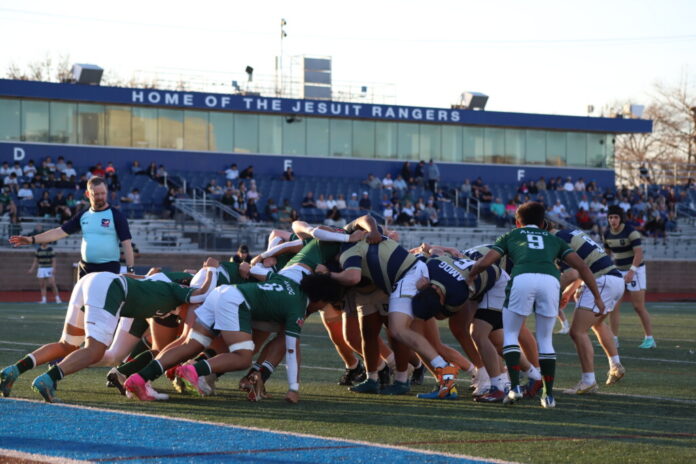What is Rugby?
The Jesuit College Preparatory School Rugby team has made their way into the Texas rugby state final many times. They have even gotten back to back wins in the 2023 and 2024 seasons. The most recent season of 2024 saw the largest Jesuit Dallas Rugby program ever in history. Over 80 students made up the Ranger’s Rugby Roster which fielded 3 separate teams which included freshmen who were brand new to the sport, to the seniors, some of whom joined in recent years while many others have played all 4 years at Jesuit. Imagine what this program could have looked like if those “clueless” kids were not eager enough to learn how to play a sport that they knew nothing of. Imagine what the future of rugby in the United States could look like if more people learned a little bit more about the sport. That is what the purpose of this article is, to give a better understanding of a sport that people know very little about and those that do know a little who find it very confusing.
A Brief History
Let’s start with a brief lesson in basic rugby history. According to rugby legend, it was a guy by the name of William Webb Ellis who invented the sport of rugby. He did this by picking up and running with a ball in his hands during a game similar to that of soccer. However, there is no official evidence to confirm this. In reality, the story of rugby begins in England where, up until the 19th century, the most popular sport was folk football. Folk football was a term used to refer to the unregulated sports played in England at the time. In Folk football, the rules of the game would be set by the rules of the home team’s rules. Generally two different sects of this sport were practiced, a foot-dribbling game, similar to soccer, and a handling game, similar to what we know as rugby today. One of the major schools advocating for the handling form of football was Rugby School, which helped the sport grow in popularity and eventually gave it its name. As the game of rugby became more widespread, it was eventually given its own title, Rugby Football and players of the sport began to have strong disagreements (that will be covered later) which led to a schism of rugby, differentiating Rugby Union from Rugby League.
Over time, all forms of rugby became more regulated, establishing more laws, enforcing penalties, and generally trying to make what was a dangerous sport less, well, dangerous. In the United States, many Ivy League schools such as Harvard and Yale introduced rugby to America, spreading English culture to the American students. In more recent times, the innovation and implementation of Rugby 7s helped the sport grow dramatically. Sevens became a quick and easy way to play rugby, making participation easier in areas where rugby clubs had not yet been established. Today, rugby is one of the most watched and most played sports around the world, demonstrated by the Rugby World Cup, the World Rugby Sevens Series, the Six Nations, and in the United States, Major League Rugby.
How Do You Play Rugby?
Background Knowledge
We will start by learning the most common form of rugby, and the one mostly referred to as just “rugby,” Rugby Union. Rugby is played on a rectangular field just slightly bigger than a football field. Like football, rugby has goal posts but they are “H” shaped instead of the “T” shape people are more familiar with, and are placed on the try line (a.k.a. the goal line) rather than the back of the try zone (a.k.a. the end zone). What we call sidelines in football are called “touch lines” in rugby. Furthermore, if the ball is not on the field then it is out of bounds or “in touch.” A game of rugby is usually played in 40 minute halves with a 15 minute halftime with the clock never stopping. The objective of the game is to obviously have more points than the opposing team. Each team can field 15 players with 8 benched players for substitution. Each player wears cleats, a mouth guard, and if they want, a scrum cap (a thin piece of cloth used to protect their heads and ears).
Positions
The players are separated into two main categories, backs and forwards and their number dictates their position. Forwards are typically the bigger and stronger players responsible for using their size to gain quick yardage and pushing against the opposing team in scrums, rucks, and mauls. Their positions, numbered in order 1-8, include loosehead prop (1), hooker (2), tighthead prop (3), lock (4), lock (5), blind-side flanker (6), open-side flanker (7), and the number 8 (8). The backs are typically smaller, more agile, faster, more skilled, and responsible for intricate plays and moving the ball around the field. Their positions include scrumhalf (9), flyhalf (10), left wing (11), inside centre (12), outside centre (13), right wing (14), and the fullback (15). The jersey numbers 16-23 do not dictate positions as these players are substitutions.
Scoring
There are 5 ways to score points in rugby and the first is the “try.” For this to happen, a ball carrier must not only successfully run the ball into the try zone, but he must also place the ball on the ground with downward pressure. A try is worth 5 points.
The second way to score points is by completing a conversion kick which happens after a try similar to extra point conversion after a touchdown in football. The conversion kick can be kicked on a tee from any distance from the posts so long as the kick is in line with where the ball was placed down in the try zone when the try was scored. This is often the reason that you will see rugby players run towards the center of the goal posts, despite already being within the try zone. A conversion kick is worth 2 points if the ball successfully clears the goal posts.

The third way to gain points in a rugby match is via a penalty kick. A penalty kick can happen once the “sir” (the referee) gives a team the option to kick after a penalty happens. The kick will then take place where the sir sets the “mark,” usually where the previous play ended or where the penalty occurred. A successful kick awards 3 points.
The fourth way to score is by a drop goal during live play, which is worth 3 points as well. This can happen at anytime during the match, but the ball must touch the ground before being kicked, as punts do not award points.
The final way to score is by the sir awarding a penalty try, which might be declared in the instance that the sir deemed that a penalty interfered with a potential try. This is worth 5 points just like a regular try.
Defense
The defending team must be sure to tackle the ball carrier below their sternum, if tackled above the sternum a penalty for a high tackle will be called. Once a defender tackles the ball carrier, they must roll away from the tackled person before doing anything else. A ruck (which will be covered later) will then form where the carrier got tackled. The defense may not pass the imaginary line running perpendicular to the sidelines placed about a meter in front of the ruck, if a defender does then it is an “offsides” penalty.
The Ruck
The ruck is probably the most confusing part of the game. There are many penalties that can be given like not rolling away, not releasing, diving in the ruck, and it is the messiest part of rugby as it involves many people on the ground pushing and shoving. Because of its complexity this will be a very basic definition. The ruck begins after a tackle where the tackled player must stay before releasing the ball. Although the defense cannot run around the previously mentioned offsides line, they can run directly through it head on, pushing into the offensive ruck and possibly steal the ball. This is called a counter ruck. In order to prevent this from happening, the offense protects the ball with one player grabbing their tackled teammate and squatting over the ball. From this position, another teammate can pick up the ball and continue the play.

Scrum
The scrum takes place after a penalty, a knock on, or in the case of a dropped ball. In the scrum, the 8 forwards bind together with their arms around each other and their shoulders pressing into each other. The two opposing teams of 8 meet at the sir’s mark. They interlock heads and push forward once the sir says “set!”. Once the scrum is set, a scrum half rolls the ball straight into the scrum from the side. Once the ball is rolled into the scrum, the two teams use their feet to try to hook the ball backwards for their respective scrum halves to pick up from the back of the scrum and continue playing.
Line out and Maul
The line out looks sort of like a cheerleading stunt and a basketball tip off simultaneously. A line out occurs after the ball goes into touch or out of bounds. In a line out, the 8 forwards for each team set up in a line perpendicular to the sideline and opposite of the opposing team. A player will then throw the ball straight down the middle of these two lines, from touch so that each team has a fair chance to snatch the ball out of the air. The process of catching the ball involves the strongest forwards lifting up the tallest forwards to gain a height advantage over the other team and steal the ball. Once caught, the jumper can throw the ball down from the sky backwards to continue play or engage a maul.

A maul happens when the jumper holds onto the ball as he is set down, then the lifters bind onto him somewhat similarly to a scrum. If the opposing team pushes in response, a maul is engaged. During a maul, the ball carrier is literally pushed down the field by a conglomerate of players.
Different Types of Rugby
Rugby League
Now that Rugby Union has been defined, we can differentiate other forms of rugby. Rugby League’s main difference to union is the absence of opposed and contested rucks. While Rugby Union has rucks in which the defense can push against the offense and possibly gain possession, Rugby League states that the defense cannot gain possession. In fact, the defense must step back 10 meters before tackling another player. League is similar to football in the sense that they get 6 “downs” to gain yardage and score before the ball is turned over. In union, there are no downs or a limited number of possessions.
This simple difference creates a whole other sport, as the game becomes more about passing and strategic plays and less brute force. Consequently, scrums and line outs are not really opposed as well, with some fans and players even advocating for the abolition of these plays in the game as they have become nearly useless. Scoring in league is also different as a try is worth 4 points, penalty goals 2, and drop goals 1 point.
Sevens Rugby
Sevens Rugby is a relatively new form of Rugby Union. Sevens Rugby is played with 7 minute halves and a 1 minute half time, rather than 40 minute halves and a 15 minute half time. Rather than rugby union which has 15 players on each side, sevens teams get 7 players on each side with 3 player line outs and scrums. One can think of Sevens Rugby as Rugby Union minus the forwards, leaving just the faster and more skilled backs. Different from union, after a try in sevens, the conversion kick must be a drop goal and may not be teed up.

Despite the lack of players, the game is still played on the same field, making those two 7 minute halves excruciatingly tiring. These differences make sevens rugby a faster paced and higher scoring game, focused on passes, endurance, speed, and strategic plays that break the defensive line. The sport puts less emphasis on heavy contact, rucks, scrums, and line outs, but they are still necessities for the game unlike rugby league. The quick and easy nature of this game has allowed for rugby to become more widespread as organized season long schedules are no longer needed, for sevens teams just need a free weekend and a handful of players.
Touch
The final form of rugby is touch rugby, a non-contact alternative to traditional rugby. Although touch is a very easy pickup sport used for both recreation and conditioning, it has become its own regulated sport. Touch leagues are competitive and played by many former contact players. Generally, the sport is similar to sevens and union with the main differences being the lack of contact, rucks, scrums, and lack of line outs. This sport puts extreme emphasis on strategies used in seven rugby, prioritizing speed and making breaks through the defensive line.
Stay tuned to The Roundup for more Rugby information and coverage!






